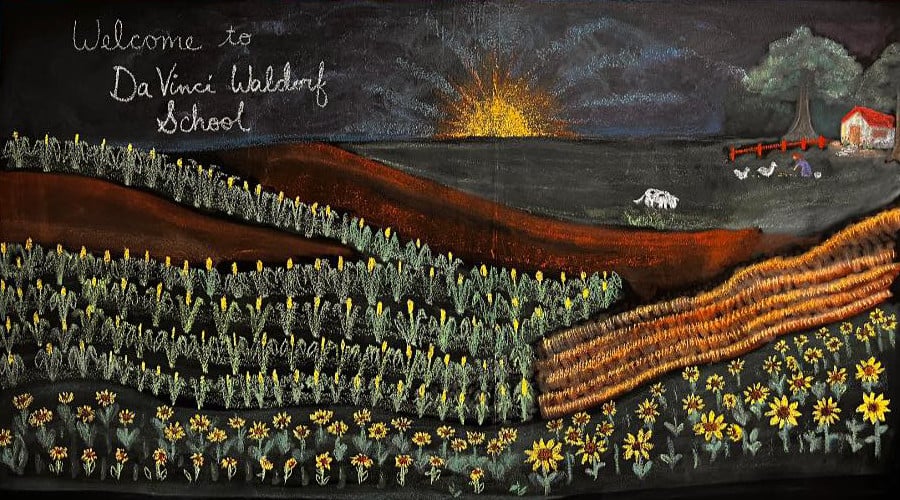Inspiring Life-long Learning for 25 Years

1st Grade: Chalkboard Drawing
 Little snail,
Little snail,
Dreaming you go,
Weather and rose
is all you know.
Weather and rose
Is all you see,
Drinking the dewdrops'
Mystery.
~Langston Hughes
1st Grade: Watercolor Painting
 Yellow streaming out into the sky. In this exercise, first graders pull the rich yellow at the base upward into near nothingness. This is the action and quality of yellow—to fly away and lighten things up.
Yellow streaming out into the sky. In this exercise, first graders pull the rich yellow at the base upward into near nothingness. This is the action and quality of yellow—to fly away and lighten things up.
1st & 2nd Grades: Apple Picking
 The first and second graders enjoyed apple picking Friday! They had tons of fun, including a game of "duck, duck, goose!"
The first and second graders enjoyed apple picking Friday! They had tons of fun, including a game of "duck, duck, goose!"
2nd Grade: Beeswax Modeling
 In preparation for their trip to the apple orchard (and in honor of the beginning of Autumn), the second graders prepared apples with Mother Earth, via beeswax modeling. What a beautiful sight here on the class's nature table!
In preparation for their trip to the apple orchard (and in honor of the beginning of Autumn), the second graders prepared apples with Mother Earth, via beeswax modeling. What a beautiful sight here on the class's nature table!
3rd Grade: A Daily Glimpse
 A look at the recent flow of a day in the life of our third graders. Their schedule is framed beautifully by a tree that changes with the seasons. Can you guess what the Mystery Class might have been?
A look at the recent flow of a day in the life of our third graders. Their schedule is framed beautifully by a tree that changes with the seasons. Can you guess what the Mystery Class might have been?
4th Grade: Painting the Tree of Life
 In conjunction with their continuing study of Norse Mythology, the fourth graders painted the tree of life, Yggdrasil. This color study involved blending the rich warm colors (darkest to light) and adding a tree for the summer season. They worked to blend each color with the next, while also allowing each to stand on its own.
In conjunction with their continuing study of Norse Mythology, the fourth graders painted the tree of life, Yggdrasil. This color study involved blending the rich warm colors (darkest to light) and adding a tree for the summer season. They worked to blend each color with the next, while also allowing each to stand on its own.
5th and 6th Grades: Botany
 The fifth and sixth graders continued their botany block. In conjunction with this, they enjoyed making (and eating!) fungi pizza on our new teaching island.
The fifth and sixth graders continued their botany block. In conjunction with this, they enjoyed making (and eating!) fungi pizza on our new teaching island.
Behold the plant!
It is bound fast
to the earth.
Behold the butterfly!
It is the plant,
set free by the universe.
~Rudolf Steiner
7th and 8th Grades: Perspective Drawing
 The 7th and 8th graders continued their studies of Art and the Renaissance. In their first perspective drawing, students were given the length and position of the first line and the last line and then asked to interpolate the position of six additional lines in between. They were then invited to convert the vertical lines into trees to form a tree line.
The 7th and 8th graders continued their studies of Art and the Renaissance. In their first perspective drawing, students were given the length and position of the first line and the last line and then asked to interpolate the position of six additional lines in between. They were then invited to convert the vertical lines into trees to form a tree line.

